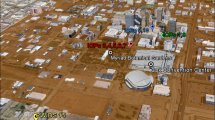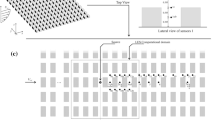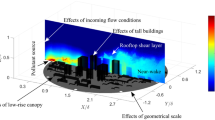Abstract
Turbulent mixing induces variability in concentration that is important in many applications, such as reactive plumes, risk assessments or odour impact analyses (when the effects can have time scales on the order of a second). In urban canopies, the variability may be modified by the presence of buildings. Our purpose is to study concentration fluctuation variance in built-up areas using an Eulerian approach. We performed numerical simulations with the computational fluid dynamics model Mercure_Saturne, which is a three-dimensional model adapted to atmospheric flow and pollutant dispersion. We use a k − ϵ turbulence closure and predict the concentration variance with a transport equation model. The model performance is evaluated with the near-full scale experiment MUST (Mock Urban Setting Test), a field experiment conducted in Utah’s West Desert Test Center. The modelled root-mean-square of the concentration fluctuations is compared to measurements for 20 of the MUST trials. The model shows good agreement with the measurements, with the fraction of predictions within a factor of two of observations of 60.1%, with better results for horizontal lines of detectors than for the detectors on vertical masts (with fractions of predictions within a factor of two of observations of respectively 66.4% and 52.6%). The influence of different parameters on the fluctuation variance is also studied and we show the importance of taking into account the stability of the stratification when modelling the turbulent kinetic energy.
Similar content being viewed by others
References
Andronopoulos S, Grigoriadis D, Robins A, Venetsanos A, Rafailidis S, Bartzis JG (2002) Three-dimensional modeling of concentration fluctuations in complicated geometry. Environ Fluid Mech 1: 415–440
Archambeau F, Mechitoua N, Sakiz M (2004) Code_Saturne : a finite volume code for the computation of turbulent incompressible flows – industrial applications. Int J Finite Volumes 1: 1–62
Biltoft CA (2001) Customer report for mock urban setting test, DPG Document No. WDTC-FR-01-121. West Desert Test Center, U.S. Army Dugway Proving Ground, Dugway, Utah, 58 pp
Cassiani M, Franzese P, Giostra U (2005a) A PDF micromixing model of dispersion for atmospheric flow. Part I: development of the model, application to homogeneous turbulence and to neutral boundary layer. Atmos Environ 39: 1457–1469
Cassiani M, Franzese P, Giostra U (2005b) A PDF micromixing model of dispersion for atmospheric flow. Part II: application to convective boundary layer. Atmos Environ 39: 1471–1479
Chang JC, Hanna SR (2004) Air quality model performance evaluation. Meteorol Atmos Phys 87: 167–196
Cohen JE, Reynolds AM (2000) Parameterization of the two-point velocity correlation function in a two-particle lagrangian stochastic model and its effect on the prediction of concentration variances due to a line source. J Appl Meteorol 39: 1762–1769
Csanady GT (1967) Concentration fluctuations in turbulent diffusion. J Atmos Sci 24: 21–28
de Haan P (2001) Predicting concentration fluctuations with a puff-particle model. Int J Environ Pollut 16: 49–56
Fackrell JE, Robins AG (1982a) Concentration fluctuations and fluxes in plumes from points sources in a turbulent boundary layer. J Fluid Mech 117: 1–26
Fackrell JE, Robins AG (1982b) The effects of source size on concentration fluctuations in plumes. Boundary- Layer Meteorol 22: 335–350
Franzese P (2003) Lagrangian stochastic modeling of a fluctuating plume in the convective boundary layer. Atmos Environ 37: 1691–1701
Gifford F (1959) Statistical properties of a fluctuating plume dispersion model. Adv Geophys 6: 117–137
Hanna SR (1984) Concentration fluctuations in a smoke plume. Atmos Environ 18: 1091–1106
Henn DS, Sykes RI (1992) Large-eddy simulation of dispsersion in the convective boundary layer. Atmos Environ 26: 3145–3159
Hsieh K-J, Lien F-S, Yee E (2007) Numerical modeling of passive scalar dispersion in an urban canopy layer. J Wind Eng Ind Aerodyn (in press). doi:10.1016/j.jweia.2007.02.028
Launder BE, Spalding DB (1974) The numerical computation of turbulent flow. Comp Meth Appl Mech Eng 3: 269–289
Lewis DM (1999) A simple model of concentration fluctuations in neutrally buoyant clouds. Boundary-Layer Meteorol 90: 117–153
Lewis DM, Chatwin PC (1997) A tree-parameter PDF for the concentration of an atmospheric pollutant. J Appl Meteorol 36: 1064–1075
Luhar AK, Sawford BL (2005) Micromixing modeling of concentration fluctuations in inhomogeneous turbulence in the convective boundary layer. Boundary-Layer Meteorol 114: 1–30
Luhar AK, Hibberd MF, Borgas MS (2000) A skewed meandering-plume model for concentration statistics in the convective boundary layer. Atmos Environ 34: 3599–3616
Milliez M, Carissimo C (2007) Numerical simulations of pollutant dispersion in an idealized urban area, for different meteorological conditions. Boundary-Layer Meteorol 122: 321–342
Mole N (2001) The large time behaviour in a model for concentration fluctuations in turbulent dispersion. Atmos Environ 35: 833–844
Mylne KR, Mason PJ (1991) Concentration fluctuation measurements in a dispersing plume at a range up to 1000m. Quart J Roy Meteorol Soc 117: 177–206
Nelson MA, Brown MJ, Pardyjak ER, Klewicki JC (2004) Area-averaged profiles over the mock urban setting test array. In: Fifth AMS symposium on the urban environment, Vancouver, British Columbia, 23–26 August 2004
Pardyjak ER, Brown MJ, Nelson M, Zajic D, Pricevac M, Biltoft C, Klewicki J (2002) Building effects on thermal stratification during the MUST trials. In: Proceedings, AMS 4th symposium on the urban environment, Norfolk, VA
Reynolds AM (2000) Representation of internal plume structure in Gifford’s meandering plume model. Atmos Environ 34: 2539–2545
Sada K, Sato A (2002) Numerical calculation of flow and stack-gas concentration fluctuation around a cubical building. Atmos Environ 36: 5527–5534
Sato A, Sada K (2002) Estimation of gas concentration fluctuations using a numerical model and comparison with those of wind tunnel experiments. In: Proceedings, 8th int. conf. on Harmonisation within atmospheric dispersion modelling for regulatory purposes, pp 215–219
Sawford BL (2004) Micro-mixing modelling of scalar fluctuations for plumes in homogeneous turbulence. Flow Turbulence Combustion 31: 133–160
Sawford BL (2006) Lagrangian stochastic modelling of chemical reaction in a scalar mixing layer. Boundary-Layer Meteorol 118: 1–23
Sykes RI, Lewellen WS, Parker SF (1984) A turbulent-transport model for concentration fluctuations and fluxes. J Fluid Mech 139: 193–218
Viollet PL (1988) On the numerical modeling of stratified flows. In: Dronkers J, Leussen W (eds) Physical processes in estuaries. Springer-Verlag, pp 257–277
Weil JC, Sykes RI, Venkatram A (1992) Evaluating air-quality models: review and outlook. J Appl Meteorol 31: 1121–1145
Wilson DJ, Robins AG, Fackrell JE (1982) Predicting the spatial distribution of concentration fluctuations from a ground level source. Atmos Environ 16: 497–504
Xie Z, Hayden P, Voke PR, Robins AG (2004) Large-eddy simulation of dispersion: comparison between elevated and ground-level sources. J Turbulence 5: 1–16
Yee E, Biltoft CA (2004) Concentration fluctuation measurements in a plume dispersing through a regular array of obstacles. Boundary-Layer Meteorol 111: 363–415
Yee E, Chan R (1997) A simple model for the probability function of concentration fluctuations in atmospheric plumes. Atmos Environ 31: 991–1002
Yee E, Wilson DJ (2000) A comparison of the detailed structure in dispersing tracer plumes measured in grid-generated turbulence with a meandering plume model incorporating internal fluctuations. Boundary-Layer Meteorol 94: 253–296
Author information
Authors and Affiliations
Corresponding author
Rights and permissions
About this article
Cite this article
Milliez, M., Carissimo, B. Computational Fluid Dynamical Modelling of Concentration Fluctuations in an Idealized Urban Area. Boundary-Layer Meteorol 127, 241–259 (2008). https://doi.org/10.1007/s10546-008-9266-1
Received:
Accepted:
Published:
Issue Date:
DOI: https://doi.org/10.1007/s10546-008-9266-1




